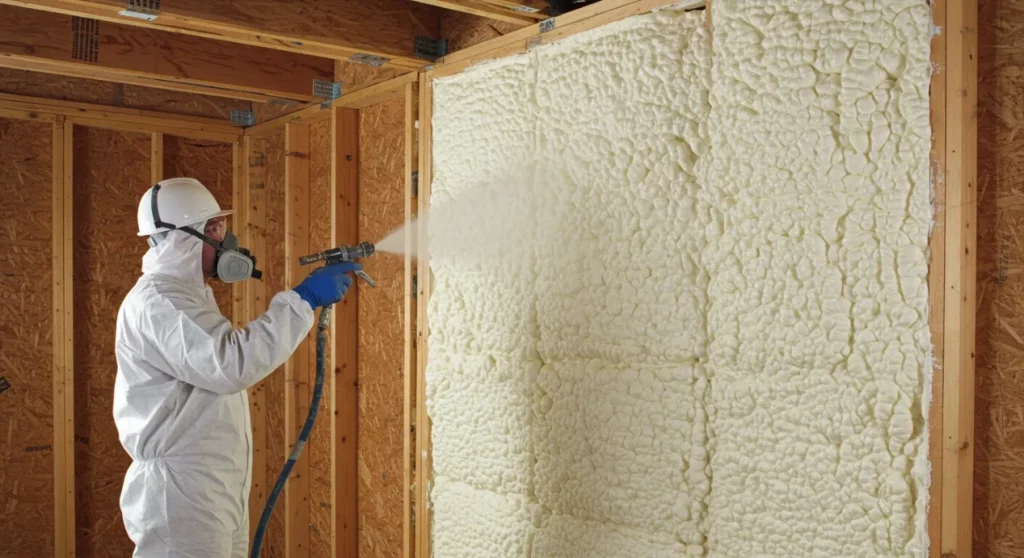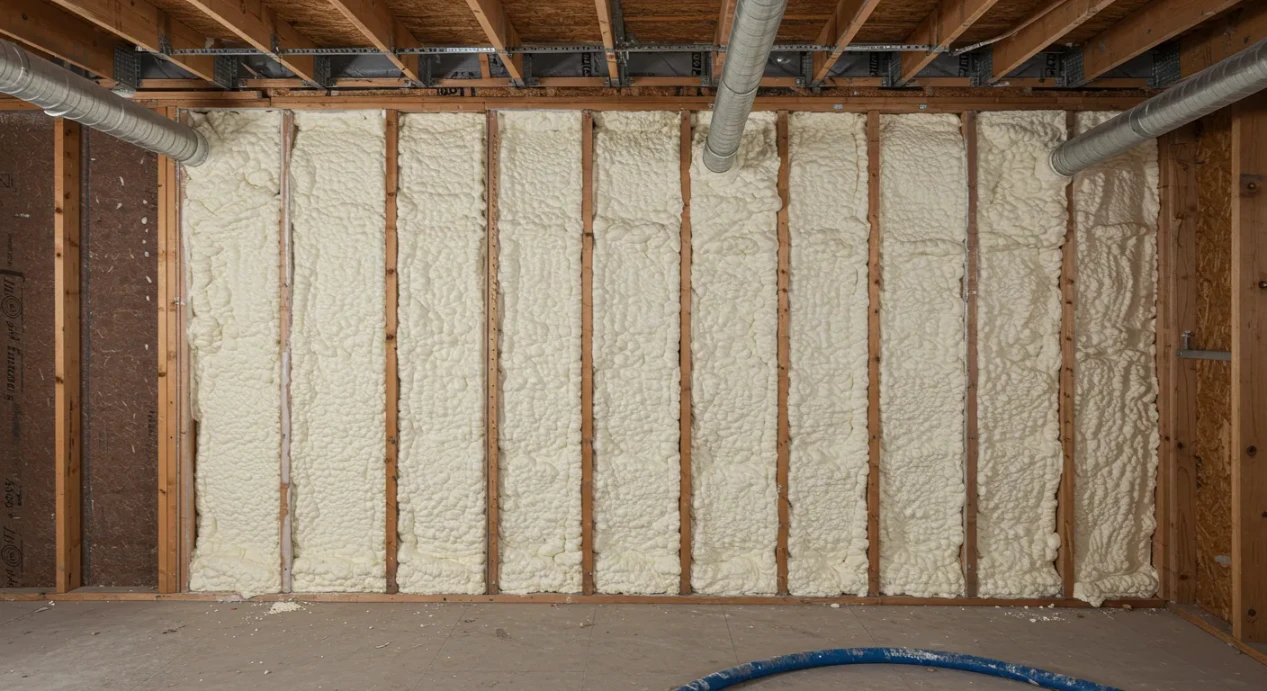Feeling frustrated by rooms that are too hot in the summer and too cold in the winter? You’re not alone. Many homeowners struggle with inconsistent temperatures, annoying drafts, and energy bills that seem to climb higher every year. These issues often point to a single culprit: inadequate insulation and air leakage. Your home might be losing a significant amount of its conditioned air through tiny gaps and cracks in the walls, attic, and crawl space. This is where a modern insulation solution can make a world of difference, and open cell spray foam is one of the most effective options available.
For years, our team has seen firsthand how the right insulation can completely change a home’s comfort and efficiency. This guide is built on that experience, designed to give you a complete understanding of open cell spray foam. It’s more than just insulation; it’s a high-performance air barrier that seals your home, quiets outside noise, and provides lasting value.
What Exactly Is Open Cell Spray Foam?
At a basic level, open cell spray foam is a type of polyurethane insulation that is applied as a liquid and expands dramatically into a soft, flexible foam. It’s created on-site by combining two chemical compounds. When sprayed onto a surface like the underside of a roof deck or into a wall cavity, the liquid mixture expands up to 100 times its original volume in just a few seconds, filling every crack and crevice.
The name “open cell” refers to the material’s internal structure. Imagine a sponge. Its bubbles, or cells, are not completely sealed off from one another. This interconnected structure is what makes the foam soft, light, and flexible. It also allows water vapor to pass through it, which is a critical feature for managing moisture in certain building applications.
This physical structure is what sets it apart from its denser counterpart, closed cell spray foam, and gives it a unique set of properties perfectly suited for residential and commercial buildings.
The Core Benefits of Open Cell Foam
While often chosen for its budget-friendly price point compared to closed cell foam, its advantages go far beyond cost. The unique properties of open cell spray foam deliver a combination of performance benefits that traditional insulation materials can’t match.
Unmatched Air Sealing
The single biggest advantage of open cell spray foam is its ability to create a near-perfect air barrier. Because it expands so aggressively, it seals all the tiny gaps, joints, and penetrations in your building envelope that allow air to leak in and out. Air leakage is a massive source of energy loss. In fact, analysis from the U.S. Department of Energy suggests that air sealing can save a homeowner 10% to 20% on their heating and cooling bills. By stopping these leaks, open cell foam helps maintain a consistent indoor temperature, reduces drafts, and lowers the strain on your HVAC system.
Superior Sound Dampening
If you’re looking to reduce noise from outside or between rooms, open cell foam is an excellent choice. Its soft, spongy texture is fantastic at absorbing sound waves. This makes it a popular option for media rooms, home offices, nurseries, and walls adjacent to laundry rooms or bathrooms. The noise reduction is a comfort-boosting benefit that many people don’t expect from their insulation.
Smart Moisture Management
Open cell foam is vapor permeable, meaning it allows water vapor to pass through it. This might sound like a bad thing, but it’s actually a sophisticated building science feature. If a roof or plumbing leak occurs, the water won’t get trapped behind the insulation. Instead, it can pass through the foam, allowing you to spot the leak on the drywall and fix it. This permeability also lets the building materials, like wood framing, dry out if they get damp, which helps prevent mold, mildew, and rot.
Expert Tip: The vapor permeability of open cell foam makes it ideal for unvented attic assemblies in many climates. It allows the roof deck to dry inward if it ever gets wet, which is a key principle of modern building science.
Flexible and Adaptable
Buildings naturally shift, settle, and expand or contract with temperature changes. Open cell foam’s soft, flexible nature allows it to move with the structure without cracking or pulling away from the studs. This ensures the air seal remains intact for the life of the building, providing consistent performance year after year.
Open Cell vs. Closed Cell Spray Foam: A Direct Comparison
Choosing the right type of spray foam insulation depends on your specific project goals, budget, and climate. Both open cell and closed cell have their place, but they are not interchangeable. Understanding their differences is key to making an informed decision.
Here’s a breakdown of how they stack up against each other:
| Feature | Open Cell Spray Foam | Closed Cell Spray Foam |
|---|---|---|
| R-Value per Inch | ~R-3.5 to R-3.8 | ~R-6.0 to R-7.0 |
| Density | Low (~0.5 lbs/cubic foot) | High (~2.0 lbs/cubic foot) |
| Air Barrier | Excellent | Excellent |
| Vapor Permeability | Permeable (lets vapor pass) | Non-permeable (acts as a vapor barrier) |
| Sound Control | Excellent | Good |
| Structural Rigidity | No, remains flexible | Yes, adds structural strength |
| Cost | Lower | Higher |
| Expansion | High (up to 100x) | Low (up to 30x) |
Key Takeaways: Open cell foam excels in air sealing and sound control at a lower cost, making it perfect for most above-grade residential applications like walls and attics. Closed cell foam provides a higher R-value in less space and acts as a vapor barrier, making it better suited for basements, foundations, and situations where space is limited or extra structural support is needed.
Prime Applications for Open Cell Spray Foam
Thanks to its versatility, open cell foam is the go-to solution for many areas of a home. Here are some of the most common and effective places to install it.
- Attics and Roof Decks: This is one of the most popular applications. Spraying the underside of the roof deck creates an unvented or “conditioned” attic space. This brings your HVAC system and ductwork inside the thermal envelope, making them operate much more efficiently.
- Exterior Walls: In new construction or major renovations, filling wall cavities with open cell foam provides both insulation and an excellent air seal, stopping drafts before they can even start.
- Floors Over Garages or Crawl Spaces: Insulating the floor of a bonus room over a garage can eliminate cold floors and make the space much more comfortable.
- Soundproofing Interior Walls: As mentioned, it’s perfect for reducing sound transmission between rooms. Applying it to the interior walls around a home theater, bathroom, or light sleeper’s bedroom can make a huge difference in household peace and quiet.
Expert Tip: While excellent for most areas, avoid using open cell foam in any location where it might come into direct contact with bulk water, like on the exterior of a foundation or in a flood-prone basement. Its open structure can absorb and hold water in those specific situations.

The Installation Process: A Step-by-Step Overview
Applying spray foam insulation is not a DIY project. It requires specialized equipment, extensive training, and strict adherence to safety protocols. A professional installation ensures you get the performance and safety you expect. The global spray foam insulation market is projected to continue growing a trend that research from Fortune Business Insights credits to its superior performance which highlights the increasing demand for professional installers.
Here’s what a typical installation by Raleigh Excel Spray Foam Insulation looks like:
- Preparation: This is the most important step. The crew will cover all surfaces not being sprayed, including windows, floors, and furniture. They will also set up a ventilation system to exhaust fumes and ensure fresh air circulation.
- Application: Certified technicians wearing full personal protective equipment (PPE), including a fresh-air respirator, will apply the two-part liquid foam. They use a specialized spray gun that heats and mixes the components right at the nozzle.
- Expansion and Curing: You can see the foam expand almost instantly. It will be tack-free within a minute and fully cured within a few hours. During this time, the property must be unoccupied to allow any vapors or odors to dissipate completely.
- Trimming and Cleanup: Once the foam is cured, any excess that has expanded beyond the wall studs is carefully trimmed away to create a flat surface for drywall. The crew then removes all protective coverings and cleans the work area.
It’s a precise process that, when done correctly, results in a perfectly sealed and insulated space.
Looking Beyond R-Value
For decades, R-value has been the standard for measuring insulation effectiveness. R-value measures a material’s resistance to conductive heat flow. While important, it doesn’t tell the whole story. The U.S. Department of Energy points out that heat also moves by convection (air movement) and radiation.
This is where spray foam shines. A wall full of R-13 fiberglass batts might seem good on paper, but if it has gaps and is not sealed properly, air can flow freely through it, completely undermining the stated R-value.
Open cell spray foam, with its typical R-value of around 3.7 per inch, might seem lower than other options. But because it creates a powerful air seal, it stops convective heat loss almost completely. This real-world performance often allows a spray-foamed home to feel more comfortable and use less energy than a home insulated to a higher R-value with a leaky, traditional product.
Key Takeaways on Performance: True thermal performance is a combination of R-value (resisting heat conduction) and air sealing (stopping heat convection). Open cell spray foam delivers on both fronts, creating a building envelope that performs exceptionally well in real-world conditions, not just in a lab.
Putting It All Together
Open cell spray foam insulation is a versatile and cost-effective solution for creating a comfortable, quiet, and energy-efficient home. Its ability to form a complete air barrier is its greatest strength, stopping drafts and energy loss in a way that traditional insulation simply can’t. Combined with its excellent sound-dampening qualities and intelligent moisture permeability, it offers a combination of benefits that improve your home from the attic to the walls.
While it’s important to understand its properties and choose the right application, open cell foam is often the perfect choice for homeowners looking for high-performance insulation without the higher cost of closed cell foam.
Need Expert Guidance?
Navigating the world of insulation can be complex, but you don’t have to do it alone. If you’re considering an upgrade and want to know if open cell spray foam is the right fit for your home, the team at Raleigh Excel Spray Foam Insulation is here to help. We can assess your specific needs and provide a clear, honest recommendation. For a professional consultation, feel free to contact us at (919) 301-9435 or email us at [email protected].
Sources
- U.S. Department of Energy– Provides information on the benefits and potential savings from air sealing a home.
- U.S. Department of Energy – Offers a general overview of insulation types and the importance of R-value and air sealing.
- Fortune Business Insights™ – Publishes market research and forecasts for the global spray foam insulation industry.
Frequently Asked Questions About Open Cell Spray Foam
How long does open cell spray foam last?
When installed correctly by a professional, open cell spray foam is an inert material that does not degrade over time. It should last for the entire life of your home, never sagging, settling, or losing its insulating properties.
Is open cell spray foam waterproof?
No, it is not waterproof. Its open cell structure allows bulk water to pass through it. This is why it’s not recommended for below-grade applications or areas with direct water exposure. For those areas, closed cell foam is the appropriate choice.
Does it have an odor?
There is a distinct odor during the application and curing process, which is why the home must be vacated. Once fully cured (typically within 24 hours), the foam is inert and odorless. Proper ventilation during and after installation is essential.
Can you install open cell foam in an existing home?
Yes, absolutely. It’s an excellent choice for retrofitting attics, crawl spaces, and rim joists in existing homes. For finished walls, installation is more complex and usually involves the “drill and fill” method, though this is more common with other types of insulation.
What is the fire rating of open cell foam?
Like most building materials, spray foam insulation is combustible. However, building codes require it to be covered by a 15-minute thermal barrier, such as 1/2-inch drywall or a special intumescent paint, to ensure fire safety. When properly covered, it meets all residential and commercial building codes.
Will it increase my home’s resale value?
Energy efficiency is a major selling point for modern homebuyers. A report from the National Association of REALTORS® shows that a large majority of agents and brokers find that promoting energy efficiency in listings is valuable. A home insulated with spray foam is quieter, more comfortable, and has lower utility bills, all of which are attractive features for potential buyers.




